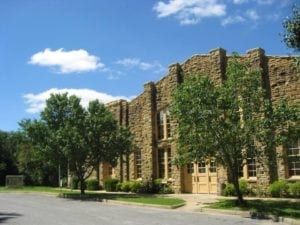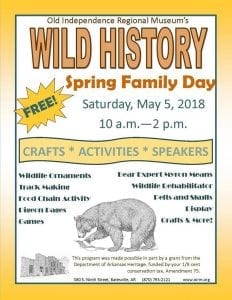Family Day at Old Independence Regional Museum – May 5th

Museum to Host Spring Family Day
Old Independence Regional Museum is going to the birds… and the bears and maybe even some butterflies! Museum staff is excited to announce plans for the annual Spring Family Day to be held Saturday, May 5, 2018 from 10:00 a.m. until 2:00 p.m. on the museum grounds. As part of Arkansas Heritage Month, the theme for this year’s family day is “Wild History,” where families can learn about native wildlife in the area from settlement days to present time. This free program will feature hands-on crafts as well as guest speakers.
If you ever wondered about the black bears in Arkansas then you can attend the presentation by guest speaker Myron Means, a bear expert with the Arkansas Game and Fish Commission, at noon. Arkansas was once known as the Bear State for our abundance of bears! Means will be speaking about the history of bears in Arkansas, bear facts and biology and the efforts to ensure that we continue to have a healthy bear population.
Not all wildlife is bear-sized, and wildlife rehabilitator Rebecca Gage will join us from Ash Flat. Gage will speak about the needs and habits of local wildlife as well as answer questions about rehabilitation and nuisance animals. People of all ages will enjoy making tracks of their own.
Rounding out the trio of special guest speakers is Nathan Reinhart, Independence County CEA and Staff Chair with U of A Cooperative Extension Service. He will be on hand with a variety of natural specimens to view and can provide information and answer questions.
A variety of games and crafts will offer children of all ages a hands-on learning experience. Children will have the opportunity to make animal salt dough ornaments and bird feeders. People of all ages will enjoy the “scent game” where you can test your nature knowledge by seeing if you can identify scents like animals do to find food and avoid predators.
To help learn about how the food chain works visitors will be making sets of nesting tubes. The tubes, which represent different links in the food chain, “nest” within each other to vividly illustrate how a food chain works. Starting with the smallest, each member of the chain is “eaten” by the next until all of them are “consumed” by the top member. Other activities include making origami birds, tie-dyed butterflies, and more. The talented Becka Paxson will be on site doing free nature themed face painting.

“We want families to enjoy their time together, learning about some of the wild creatures native to our area. This will also be a great opportunity for families to visit the museum free of charge,” stated Terri Crawford, Humanities Educator. The gift shop, stocked with items from local artists, authors, and crafters, will also be open to the public.
Spring Family Day is an annual event for Old Independence Regional Museum, but this year the program is made possible in part by a grant from the Department of Arkansas heritage, funded by your 1/8 cent conservation tax, Amendment 75. This year’s theme, “Off the Beaten Path: Explore and Enjoy Arkansas’s Natural Heritage,” will highlight the work of the Arkansas Natural Heritage Commission (ANHC), one of the divisions of the Department of Arkansas Heritage. ANHC works to conserve the state’s natural landscape and biological diversity through research, stewardship of public lands and educational outreach.
Old Independence serves a 12-county area: Baxter, Cleburne, Fulton, Independence, Izard, Jackson, Marion, Poinsett, Sharp, Stone, White, and Woodruff. Parts of these present-day counties comprised the original Independence County in 1820s Arkansas territory.
The museum is open Tuesday-Saturday, 9:00 a.m. to 5:00 p.m. Admission is $5.00 for adults, $3.00 for seniors, veterans and students, and $2.00 for children 6-12. The museum is located at 380 South 9th Street, between Boswell and Vine Streets in Batesville.
This humanities program is made possible by local support from Independence County and the City of Batesville, as well as by Challenge Grant Endowment funding from the National Endowment of the Humanities. Any views, findings, conclusions or recommendations expressed in this program do not necessarily represent those of the National Endowment for the Humanities.

